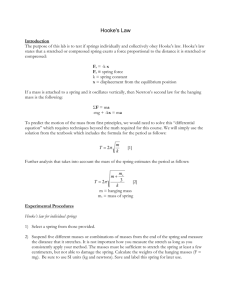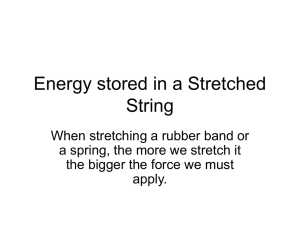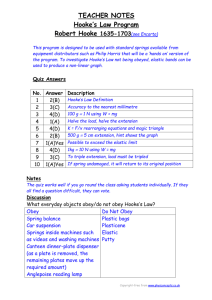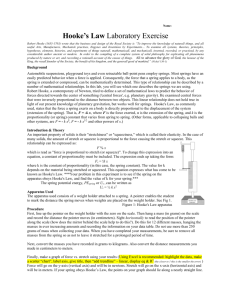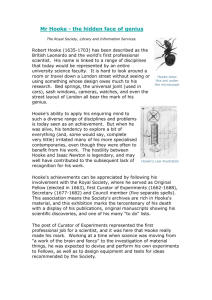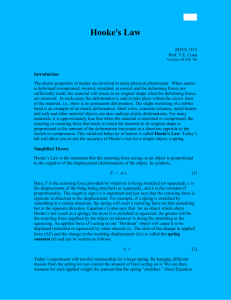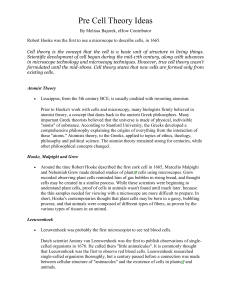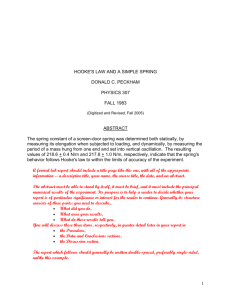Hooke`s Law and Potential Energy
advertisement
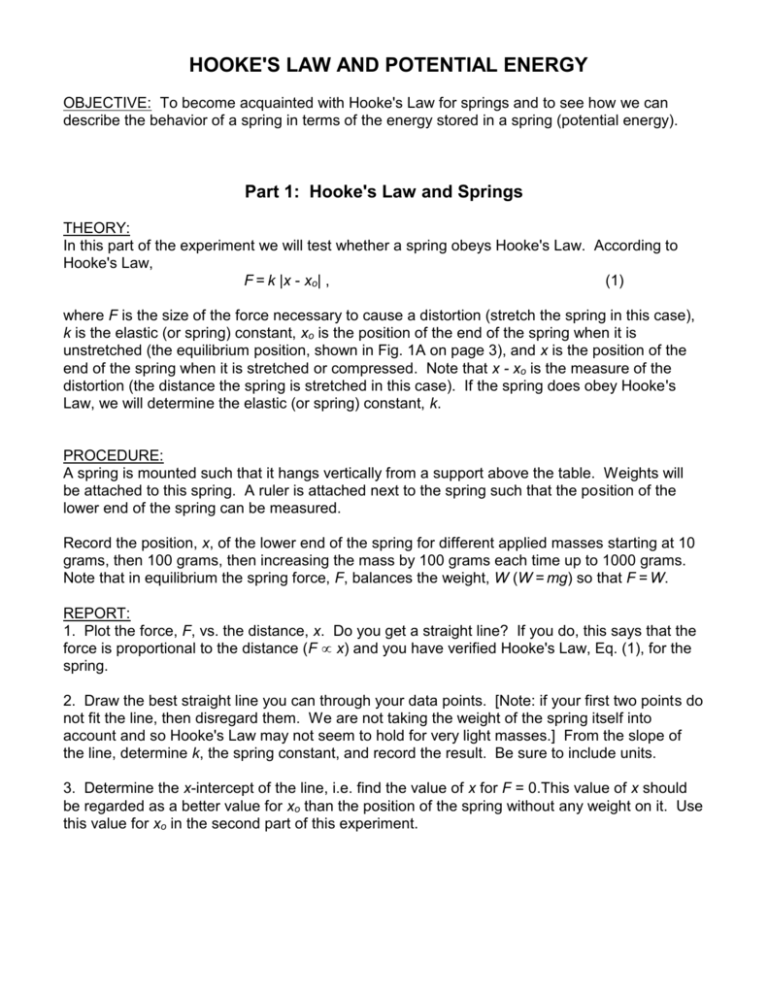
HOOKE'S LAW AND POTENTIAL ENERGY OBJECTIVE: To become acquainted with Hooke's Law for springs and to see how we can describe the behavior of a spring in terms of the energy stored in a spring (potential energy). Part 1: Hooke's Law and Springs THEORY: In this part of the experiment we will test whether a spring obeys Hooke's Law. According to Hooke's Law, F = k |x - xo| , (1) where F is the size of the force necessary to cause a distortion (stretch the spring in this case), k is the elastic (or spring) constant, xo is the position of the end of the spring when it is unstretched (the equilibrium position, shown in Fig. 1A on page 3), and x is the position of the end of the spring when it is stretched or compressed. Note that x - xo is the measure of the distortion (the distance the spring is stretched in this case). If the spring does obey Hooke's Law, we will determine the elastic (or spring) constant, k. PROCEDURE: A spring is mounted such that it hangs vertically from a support above the table. Weights will be attached to this spring. A ruler is attached next to the spring such that the position of the lower end of the spring can be measured. Record the position, x, of the lower end of the spring for different applied masses starting at 10 grams, then 100 grams, then increasing the mass by 100 grams each time up to 1000 grams. Note that in equilibrium the spring force, F, balances the weight, W (W = mg) so that F = W. REPORT: 1. Plot the force, F, vs. the distance, x. Do you get a straight line? If you do, this says that the force is proportional to the distance (F x) and you have verified Hooke's Law, Eq. (1), for the spring. 2. Draw the best straight line you can through your data points. [Note: if your first two points do not fit the line, then disregard them. We are not taking the weight of the spring itself into account and so Hooke's Law may not seem to hold for very light masses.] From the slope of the line, determine k, the spring constant, and record the result. Be sure to include units. 3. Determine the x-intercept of the line, i.e. find the value of x for F = 0.This value of x should be regarded as a better value for xo than the position of the spring without any weight on it. Use this value for xo in the second part of this experiment. Hooke’s Law and Potential Energy 2 Part 2: Energy Stored in a Spring (Potential Energy) THEORY: In this part of the experiment we will test the equation for the energy stored in a spring. Let's take down to be the positive direction so that the force exerted on the hanging mass can be written as Fx = -k(x-xo). Note that if the spring is stretched, x is greater than xo and the force is negative, meaning it point upwards. Conversely, if the spring is compressed, x is less than xo and the force is positive and points downwards. The work done by the spring force over some small displacement x is given by W = Fxx. Recall that the work done by a conservative force, such as a spring force, is the difference between the initial value of the potential energy function and the final value, W = PEI - PEf. Since '' always means final value minus initial value, the work can be expressed as W = -PE. Thus, we can write PE = -Fxx. We let the displacement get small, so this becomes d(PE)/dx = -Fx. Integrating both sides with respect to x gives the potential energy function to within an integration constant: 1 PE Fx dx k ( x xo )dx k ( x xo )2 C . 2 We choose C = 0 so that PE is zero at x = xo and the potential energy function is 1 PE spring k ( x x o ) 2 (2) 2 Often the distance axis is made so that the equilibrium position is zero (xo = 0) which simplifies Eq. (2) to PE = (1/2)kx 2. We will test Eq. (2) by setting the spring oscillating and using the Law of Conservation of Energy which states that the energy of a system at a certain time plus any work done on the system is equal to the energy of the system at a later time plus any work done by the system (which may include frictional terms): KEi + PEi + Won = KEf + PEf + Wby . (3) In this experiment we will neglect frictional terms and we will not do any work on the system between the two times we measure the energy. The energy of the system consists of the potential energy stored in the spring [Eq. (2)], the kinetic energy of the oscillating mass [KE = (1/2)mv 2], and the gravitational potential energy of the hanging mass [PEgravity = mgh, where g is the acceleration due to gravity = 9.8 m/s2, and h is the height of the mass above some reference point]. In practice, it is hard to measure v, the speed of the mass. We can overcome this by looking for points at which the speed is zero. This happens at x = xbottom and x = xtop. (See Figure 1B.) Hence, the kinetic energy is zero at both places making the conservation of energy equation easier to work with: [PEspring + PEgravity]at x-bottom = [PEspring + PEgravity]at x-top (4) (1/2)k(xbottom - xo)2 + mghbottom = (1/2)k(xtop - xo)2 + mghtop (5) or Hooke’s Law and Potential Energy 3 We can re-write this last equation as: (1/2)k(xbottom - xo)2 - (1/2)k(xtop - xo)2 = mghtop - mghbottom (6) Now note that htop - hbottom = xtop - xbottom = x. From this our energy equation becomes: (1/2)k [(xbottom - xo)2 - (xtop - xo)2 ] = mgx (7) PROCEDURE: 1. To start this part of the experiment, hang a mass of 1500 grams from the spring and note the position, x, just as you did in Part 1. Now pull the mass down 5.0 cm and record this position and label it xbottom. Now release the mass and estimate the highest position that the mass reaches before it starts to fall down again. Do this several times and take the average of all the trials. Label this average xtop. 2. Now substitute your values for k (from Part 1), m, g, xo, xtop, xbottom, and x into Eq. (7). Does this equation balance? If it does (within experimental uncertainty), we have verified Eq. (2), that 1 PE spring k ( x x o ) 2 . 2 3. Repeat this procedure (Steps 1 and 2) using a 2000 gram mass. 4. Repeat this procedure (Steps 1 & 2) using a 1000 gram mass. REPORT: 1. Perform the calculations described in the Procedure. 2. Does the weight of the mass seem to affect the degree to which Eq. (7) balances? Why or why not? xo xtop m x xbottom m FIGURE 1A FIGURE 1B

